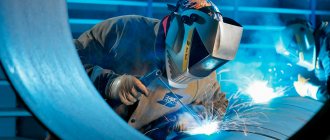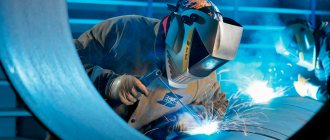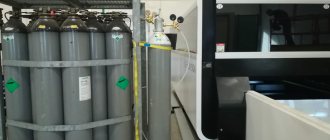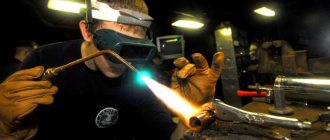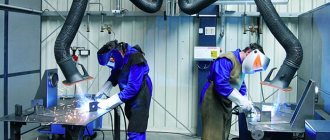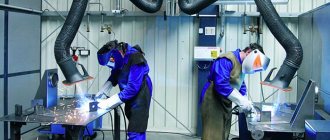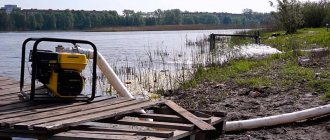Electroplating as a technology for processing metal products is an electrochemical process, the participants of which are the workpiece, an electrolyte, two electrodes and an electric current. An electrolyte is a conductive liquid substance from which, as a result of the passage of an electric current through it, metal molecules are released, deposited on the surface of the workpiece and forming a thin film on it. Galvanic coatings, which is what makes them remarkable, are formed not by simply applying a layer of metal to the surface being treated, but as a result of the penetration of its molecules into the surface layer of the part.
Electroplating is a reliable way to obtain a protective or decorative coating on metal products
Equipment for work. Bath
These workshops have a variety of equipment, but the main one is a galvanic bath. This device is divided into two types. The first is called active, the second - auxiliary. They differ in that in the first types of baths the required coating is directly applied to the product. In the auxiliary equipment of the galvanic workshop, the stage of preparing the part for the further procedure takes place. The important thing to understand here is that auxiliary equipment is just as important as the main one. Among them are baths for washing, drying, and preparing the mixture.
Bathtub design
The design of the baths in the galvanizing shop is quite simple and is a cube that has additional stiffeners, as well as some additional elements. Among such additional devices, for example, there is a heating element, a lid, filtration, a cooling system, a water supply and drainage system, cleaning systems, suspensions, anodes, etc.
For the production of such things, stainless steel, PVC, polypropylene, as well as other raw materials with similar characteristics can be used. However, at present, PVC and polypropylene are the most widely used, and steel and metal products have faded into the background. This is due to the fact that polymer materials are more resistant to aggressive chemicals and high temperatures.
Occupational hygiene of galvanic production worker
Electroplating
- electrolytic deposition of a thin layer of metal on the surface of a metal object to protect it from corrosion, increase wear resistance, protect against cementation, for decorative purposes, etc. The resulting galvanic coatings - deposits - must be dense and fine-grained in structure. To achieve a fine-grained structure of deposits, it is necessary to select the appropriate electrolyte composition, temperature conditions and current density.
Zinc coating protects ferrous metals from corrosive destruction not only mechanically, but also electrochemically. Zinc coatings are widely used to protect machine parts and fasteners from corrosion; they are used to protect against corrosion water pipes, feed tanks in contact with fresh water at a temperature not exceeding 60-70 ° C, as well as to protect ferrous metal products from gasoline and oils, etc. In an environment saturated with sea fumes, zinc coatings are not durable.
Special purpose devices
Electroplating production requires special-purpose baths that are designed to work with small parts.
The first equipment of this type is a bell bath. The main difference between this type of device and the main one is that it has a special bell, and the main purpose is to apply galvanic coating to small parts in bulk form. The bell itself is truncated and has a multifaceted design. Such a device is used both as a stand-alone machine and in a line.
Electroplating production periodically requires equipment such as a galvanic drum. It is a prism, which is made of either PVC or polypropylene, which has many edges, all of which are perforated. To rotate such a prism, a motor with a gearbox is used, and torque is transmitted through a gear-type wheel system. The drum can be used in manual, automated and mechanized line types.
The profession of galvanizer refers to work in difficult conditions.
By Resolution of the Cabinet of Ministers of the USSR No. 10 of January 26, 1991, List No. 2 of industries, jobs, professions, positions and indicators with harmful and difficult working conditions was approved, on the basis of which a pension is assigned in connection with special working conditions.
11/10/1960 b. I have 40 years of insurance experience, of which 4 years worked as a galvanizer and 1 year as a train compiler on the railway (harmful work is 5 years, i.e. less than half of 12 years and 6 months). He served in the army as a conscript in 1978-80. He was conscripted from the factory. When can I retire?
What is a line
A galvanic line is a set of several devices that operate in one area. The main parameters for the design of such systems are their performance, as well as the dimensions of the product for which this line should be designed. The type of line will directly depend on how large the dimensions of the product will be and what its serialization will be. Galvanic lines can be of the screw type, they can be manual or manual with a telpher. Today, the automatic operator type of line, which has software control, is becoming very popular.
The line may also include auxiliary equipment. It is necessary in order to withstand the technological process, as well as ensure complete safety of work for people on the site.
Types of auxiliary installations
Electroplating equipment used at sites must prepare raw materials and components for further work. For this purpose, for example, there are two filter units. One of them is stationary, the other is mobile.
If we talk about the first type of installation, then the UFE-1S model is usually used. It is intended for filtering either water or electrolyte from any mechanical impurities. An additional feature of the stationary type is that it can be connected to an airless mixing system, which has a solution filtration function.
A mobile type filter is usually represented by the UV 2400 model. It can be used, like a stationary one, to filter electrolyte or water from mechanical contaminants. Their difference is that this pump can also pump this water or other aggressive chemicals.
Liquid demineralization devices are also used. The unit is presented in the form of an UVD-500 installation, which is capable of removing salt from a liquid so that it fully complies with a state standard such as 6709-97. This water is used to prepare a new electrolyte, as well as for any washing operations carried out in the workshop.
There is also smaller-scale equipment, for example, conventional pumps, but with increased resistance to chemicals in order to successfully pump electrolyte. Equipment is used for drying products.
Environmental problems of electroplating production
Heavy metal ions are zinc, nickel, chromium, copper, tin, lead... and a good part of the entire periodic table. And they merge because sooner or later the coating electrolytes fail, and their volumes and replacement frequency are significant. Of course, it’s easier to pour everything into the nearest reservoir or bury it in the forest if we are talking about 50 liters or 10 kg per year. But what if it’s tens of cubic meters per week or tons per month? How aware are we of this (we should mention here our right to know the extent of the harm and receive compensation for it)? As a result, we have hundreds of tons of toxic waste. How are they harmful? Most ITMs are carcinogenic, meaning that they cause cancer. They accumulate in the body and leave it very slowly. Chromium, for example, can be absorbed even through the skin and exhibits carcinogenic effects in extremely low concentrations. Here we note that hexavalent chromium is the most harmful - the main component of chromium plating electrolytes, as well as zinc passivation.
We recommend reading: Will bailiffs be able to remove his wife’s debt from a husband’s deposit?
Ways of ITM entering the human body. On the issue of waste treatment. Until now, the most common method of recycling galvanic waste is the reagent method. Its essence is that all waste is converted into a solid, slightly soluble state by treatment with special reagents. Then tons of such waste are buried in special landfills. There are not enough such landfills in the Urals. And it’s quite logical to ask, where does the waste go? Even many directors of enterprises where this waste is generated do not know the answer to this question. And dislocating them in public landfills is perhaps the best thing to do with them. But even if the waste is buried correctly, this does not mean that it is neutralized. So, although the buried compounds (mainly hydroxides) are poorly soluble, a certain part of them still enters drinking water sources with rain, melt, and groundwater, and from there into our body. Or these compounds accumulate in the plants that livestock eat or in the water they drink. Then ITM accumulate in meat, milk, and animal fat and joyfully arrive on our table, continuing their expansion. As mentioned earlier, the human body leaves ITM with great reluctance.
Ventilation
Ventilation of a galvanizing shop is one of the most important occupational safety requirements. This is very important, since during the galvanic process, that is, the coating of products, harmful vapors are released into the air, which are dangerous not only for humans, but also for the room where they are released. Because of this, when designing a workshop, special attention is paid to ventilation equipment and ventilation in general.
For this type of workshop, it is allowed to use ventilation pipes made of polypropylene. This is due to the fact that this material belongs to the group of non-flammable ones, is moisture-proof, resistant to chemical influences, and is also very easy to install both on the ceiling, floor or walls.
Result evaluation
Upon completion of processing, experts evaluate the final result. If galvanizing work is carried out by professionals, there is no need to doubt the high quality of the coating. Using precision instruments, the thickness of the applied metal layer, uniformity of the coating, and other criteria are assessed.
Individuals or legal entities can contact us regarding galvanization. Any client idea will be submitted to our technologists for consideration!
Technologists at 6 Micron LLC have extensive experience in the field of electroplating and preparatory stages. Coating can be applied either according to a strict specification or according to a simple verbal description. Electroplating is our specialty!
Gordienko Anastasia Vadimovna Author of the materials Position: chief technologist of 6 Micron LLC Education: higher Experience in galvanizing: 13 years
When placing an order online, get a 10% discount!
Our priority is an individual approach to each order and the quality of the work performed!
Send a request or ask a question:
4.2/5 — (526 votes)
Workshop safety
The harmfulness of the galvanic shop to human health is quite high. The thing is that there are several very dangerous factors. Firstly, there is the possibility of receiving a strong electric shock, secondly, there is a risk of getting chemical, alkaline or acid types of burns, and thirdly, there is a risk of explosion and fire.
However, the harm to human health does not end there. For example, when preparing a product, it is subjected to mechanical types of processing. This can be grinding, blast cleaning using mechanical dust and many others. All of them are united by the fact that during their implementation a huge amount of dust is released into the air. In addition, the noise and vibration levels exceed permissible limits. Since electric current is used during coating, the likelihood of injury from this same current greatly increases. For this reason, direct current with a voltage of 12 V is most often used. However, there are some operations that require increasing the voltage to 120 V. For example, this occurs when it is necessary to oxidize aluminum.
Fire safety requirements for electroplating shops are also quite high. To prevent fire in such premises, it is necessary to use fire prevention and fire protection systems that will comply with GOST 12.1.004-76. Explosion safety in such areas must be ensured using explosion prevention and explosion protection measures in accordance with GOST 12.1.010-76.
Chromic anhydride
From a technical point of view, it is a combination of two substances such as chromium and oxygen. It is very often used in the chemical industry, and therefore is often called chemical acid. This substance dissolves quite well in water, which is excellent for use in workshops where most operations are carried out with liquid content to one degree or another. Chromic anhydride is currently most widely used in three areas: mechanical engineering, metallurgy, chemical and petrochemical industries. Depending on its purpose, this substance is produced in three categories: A, B and C.
- Grade A is used in cases where, under production conditions, it is necessary to obtain metallic chromium or other materials, but with sufficiently high hardness values.
- Grade B is used for the production of electrolytic chromium and in the production of catalysts. It is this anhydride that is used in electroplating shops.
- As for grade B, it is most suitable for raw material foundry operations.
Generally speaking, this type of workshop is extremely necessary, but at the same time quite harmful and dangerous. Because of this, all safety requirements must be met and the best ventilation must be installed.
Why is galvanization harmful to the body?
Substances used to prepare solutions such as alkalis and acids can cause poisoning, a solution of soda ash, like chromium, burns the mucous membrane, hydrochloric acid is a very harmful substance, as it causes chronic poisoning, tooth decay, and inflammatory skin diseases.
The need to coat metals is primarily due to the possibility of corrosion and breakage. It is also used for reasons of beauty. There is a galvanic shop to work on metal coating. Harmfulness, unfortunately, is an integral part of it. In order to work in a galvanizing shop, you need to have numerous skills, and understand that there is danger at every turn.
Immersion of parts into baths and removal from them must be done under stress-free conditions. Products should be lowered into the solution and removed from it only with tongs or on hangers smoothly, avoiding splashing of the electrolyte. Small items are immersed in the solution in steel wire baskets.
For example, drinking standing water from galvanized vessels is not recommended - soluble zinc compounds will have a negative effect on the gastrointestinal tract. Metal dust can cause lung pathology. Zinc phosphide used for rodent control is extremely dangerous for humans. The harm of zinc mainly manifests itself in contact with modifications of the element into complex compounds. Although zinc metal itself is neutral for humans. This method was named after the Italian doctor L.
In addition to the supply and exhaust ventilation device, the removal of electrolyte and harmful gases and vapors from the surface of galvanic and pickling baths can be combated by using additives or protective liquids. Powdered substances in the form of blood serum, cake, etc. are currently widely used as protective additives for pickling baths, and oil distillation fractions with a boiling point in the range of 190–260°C are recommended for electroplating baths.
Among skin lesions among workers in galvanizing shops, eczema and dermatitis among nickel plating workers, caused by nickel salts, are in first place in frequency. Degreasing the skin of the hands under the influence of alkalis and organic solvents, as well as elevated bath temperatures and high current densities increase sensitivity to nickel. Diseases of the skin of the hands of chrome workers in the form of chrome ulcers, ulcerations, eczema and dermatitis are relatively rare. Much more often than damage to the skin of the hands, chrome platers experience damage to the mucous membrane of the nose and upper respiratory tract.
The place of work of a galvanizer is a galvanic workshop, where production conditions are extremely harmful. Firstly, during galvanization, harmful substances are released, which affects the condition of the mucous membranes and internal organs. Secondly, aggressive substances interact with human skin, which can lead to burns or various diseases of the epidermis.
You may like => Child benefit amount in 2022
Today, galvanization is actively used in the mechanical engineering industry. In addition, it is necessary in construction, aviation, space industries, healthcare and even design. In addition, with the proper level of qualifications, it is possible to open your own electroplating workshop.
